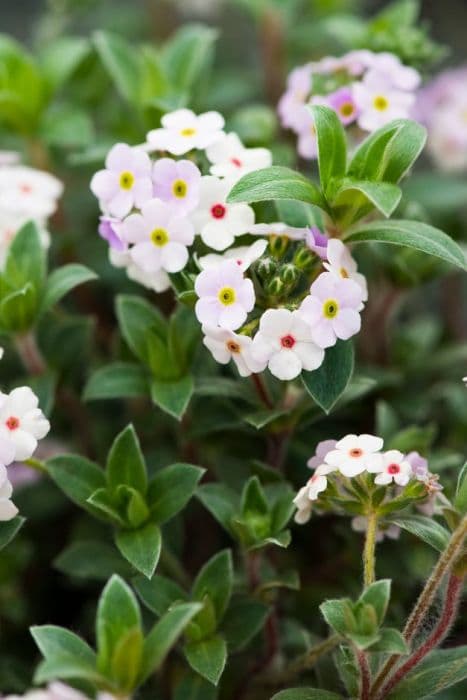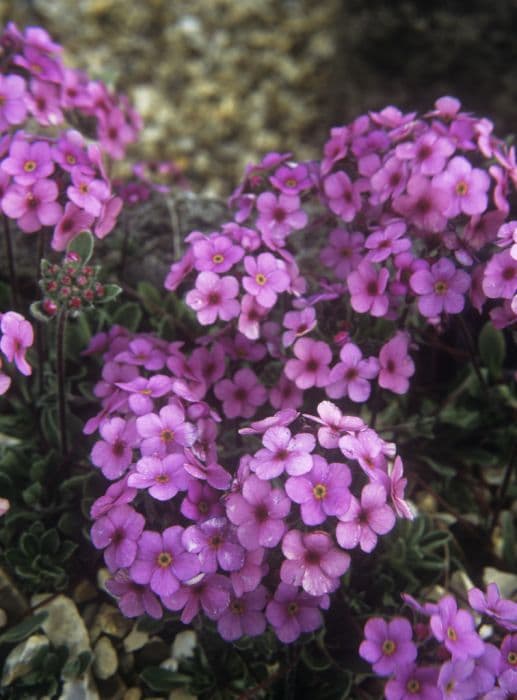Wilson's Primrose Primula wilsonii (Pf)

ABOUT
Primula wilsonii, commonly known as Wilson's primrose, is a plant that typically features a basal rosette of leaves from which emerges a flowering stem. The leaves have an oblong to spoon-shaped appearance, with edges that can be either smooth or slightly toothed and often have a wrinkled texture. They are usually bright to dark green, providing a lush backdrop for the flowers. The most striking feature of Wilson's primrose is its blooms, which are arranged in a cluster at the top of the stem, forming a rounded inflorescence. The flowers of this plant have a distinct, tubular structure with a short, narrow base that flares out into five rounded petals, creating a funnel-like shape. The petals can range from light pink to deep magenta, often with a yellow to orange center, where the reproductive parts of the flower are located. The vivid colors and the delicate structure of the blooms make them stand out vividly against the green foliage. Aside from the bright flowers, Wilson's primrose may also bear spherical seed capsules after the blooming period. These capsules contain numerous tiny seeds that can spread and give rise to new plants, ensuring the propagation of the species. The whole plant gives off a lush, vibrant look that is characteristic of many primrose species, making Wilson's primrose an attractive addition to gardens and natural settings where it may be found.
About this plant
 Names
NamesFamily
Primulaceae
Synonyms
Wilson's Primrose
Common names
Primula wilsonii var. anisodora, Primula wilsonii var. meeboldii, Primula wilsonii var. chionantha, Primula wilsonii var. orbicularis.
 Toxicity
ToxicityTo humans
Primula wilsonii, commonly known as Wilson's primrose, is not widely known to be toxic to humans. However, as with many plants, individual allergies and sensitivities can exist. If a person were to ingest parts of this plant and have a sensitivity to it, they might experience mild symptoms such as nausea, vomiting, or diarrhea. It's always best to err on the side of caution and not consume parts of ornamental plants unless they are known to be edible.
To pets
Wilson's primrose is not commonly listed as a toxic plant for pets. However, pets can have different sensitivities, and consumption of plant material can sometimes lead to gastrointestinal upset, such as vomiting or diarrhea. It’s generally advisable to prevent pets from ingesting this plant, especially in large quantities, as it could potentially lead to stomach discomfort or more serious symptoms if the animal has a particular sensitivity.
 Characteristics
CharacteristicsLife cycle
Perennials
Foliage type
Deciduous
Color of leaves
Green
Flower color
Mixed
Height
1 foot 2-3 inches (35-40 cm)
Spread
1 foot (30 cm)
Plant type
Herb
Hardiness zones
7
Native area
China
Benefits
 General Benefits
General Benefits- Aesthetic Appeal: Primula wilsonii, commonly known as Wilson's primrose, is valued for its vibrant pink and purple flowers that add color and beauty to gardens.
- Habitat for Wildlife: The plant provides nectar for pollinators such as bees and butterflies, thereby supporting local biodiversity.
- Ornamental Gardening: With its compact size and attractive foliage, Wilson's primrose is ideal for borders, rock gardens, and containers.
- Drought Tolerance: Once established, it can tolerate periods of low water, making it suitable for xeriscaping and reducing the need for irrigation.
- Low Maintenance: Primula wilsonii typically requires minimal care, making it a good choice for gardeners seeking low-maintenance plants.
- Cold Hardy: Able to withstand cold temperatures, it is suitable for growing in a range of climates, including cooler regions.
- Seasonal Interest: Its blooms offer a splash of color in late spring to summer, providing visual interest during these seasons.
- Soil Enrichment: When the plant decays, it can help add organic matter to the soil, improving soil health and structure.
- Erosion Control: Its root system can help stabilize soil, reducing erosion in sloped gardens or areas prone to runoff.
- Edging Plants: Because of their compact growth habit, Wilson's primrose is effective as an edging plant, creating natural borders along paths and garden beds.
 Medical Properties
Medical Properties- This plant is not used for medical purposes.
 Air-purifying Qualities
Air-purifying QualitiesThis plant is not specifically known for air purifying qualities.
 Other Uses
Other Uses- Primula wilsonii, commonly known as Wilson's primrose, can be used as a natural dye source. The flowers, when processed, can impart a range of colors to fabrics.
- The leaves of Wilson's primrose may be utilized in the creation of eco prints where the natural shapes and pigments of the leaves are transferred to paper or cloth through a steaming process.
- In some cultures, the vibrant flowers of the Wilson's primrose are used for ornamental purposes in festivals and religious ceremonies as symbols of youth and renewal.
- The plant can be used in companion planting to attract beneficial insects such as bees and butterflies, which aid in the pollination of surrounding plants.
- Wilson's primrose can serve as a living mulch, providing ground cover that suppresses weeds and conserves soil moisture in garden beds.
- The soaked seeds of the primrose can be used as a gentle abrasive for cleaning delicate items like jewelry or as an ingredient in exfoliating creams.
- Through flower arranging, the vibrant blooms add aesthetic value and are used in creating natural art or for educational purposes such as botanical illustration classes.
- Garden designers use the Wilson's primrose to create color-themed gardens, utilizing its specific hue to complement or contrast with other plantings.
- The unique shape and structure of Wilson's primrose leaves can be used as inspiration in design, art, and architecture, translating natural forms into creative patterns.
- Wilson's primrose seed pods can be collected and used in various crafting activities, such as making plant-based jewelry or decorative items.
Interesting Facts
 Feng Shui
Feng ShuiThe plant Primula wilsonii, commonly known as Wilson's primrose, is not used in Feng Shui practice.
 Zodiac Sign Compitability
Zodiac Sign CompitabilityWilson's primrose is not used in astrology practice.
 Plant Symbolism
Plant Symbolism- Youth and Renewal: Primroses, including Primula wilsonii, often symbolize youth due to their early spring blooming, representing new life and fresh beginnings.
- Hope and Positivity: With their bright and varied colors, primroses are often associated with hope, optimism, and the ability to triumph over adversity.
- Love and Affection: In the language of flowers, giving someone primroses can convey a message of love and caring, sometimes specifically young love or admiration.
- Protection and Safety: Some cultures believe that primroses provide protection against evil and bring safety to the household when planted by the doorstep.
 Water
WaterWilson's Primrose should be watered thoroughly but infrequently, allowing the soil to dry out slightly between waterings. Ideally, you should water this plant about once a week with about one to two gallons, depending on the size of the plant and the environmental conditions. Reduce watering in the winter when the plant is not actively growing.
 Light
LightWilson's Primrose thrives best in partial shade, preferably receiving morning sunlight and afternoon shade. Avoid placing it in full sun, especially during hot summer months, as it may cause the leaves to wilt.
 Temperature
TemperatureFor Wilson's Primrose, the ideal temperature range is between 50°F and 75°F. This plant can survive minimum temperatures down to around 32°F, but should not be exposed to prolonged periods of frost. Maximum temperatures should not exceed 80°F for extended periods.
 Pruning
PruningPrune Wilson's Primrose to remove dead or faded flowers and to encourage a second bloom. The best time for pruning is immediately after the first flowering period ends, typically in late spring or early summer. Occasional trimming may be needed to maintain the plant's shape.
 Cleaning
CleaningAs needed
 Soil
SoilWilson's Primrose prefers a moist, well-draining soil with a high organic matter content. The soil should be acidic to neutral with a pH range of 5.0 to 7.0. A suitable soil mix can be created with equal parts peat, loam, and coarse sand to ensure proper drainage and aeration.
 Repotting
RepottingWilson's Primrose should be repotted every 1 to 2 years to refresh the soil and accommodate root growth. The best time to repot is after blooming, typically in late spring or early summer.
 Humidity & Misting
Humidity & MistingWilson's Primrose thrives in moderately high humidity levels, ideally between 50% to 70%. Consistent humidity is vital for its optimal growth and to replicate its natural humid environment.
 Suitable locations
Suitable locationsIndoor
Keep in bright, indirect light with moist soil.
Outdoor
Plant in dappled shade with moist, rich soil.
Hardiness zone
5-7 USDA
 Life cycle
Life cyclePrimula wilsonii, commonly known as Wilson's primrose, starts its life as a seed, typically dispersed by wind or animals. Upon finding a suitable damp and shaded environment, the seed germinates, typically in spring, and a small seedling emerges, developing a root system and a rosette of leaves. As the plant matures through the vegetative stage, it develops a more robust root system and larger leaf area for photosynthesis during its first year. The following year, Wilson's primrose enters the reproductive stage, producing flowering stalks with clusters of flowers that are usually pink or purple, which attract pollinators like bees and butterflies. After pollination, the flowers will produce capsules containing numerous tiny seeds, completing the cycle when these seeds are dispersed. The plant may then enter a period of dormancy, especially in colder climates, to survive the winter before resuming growth in the spring.
 Propogation
PropogationPropogation time
Spring-Early Summer
Primula wilsonii, also known as Wilson's primrose, can be propagated effectively from seeds. The most popular method involves sowing seeds in late winter or early spring. Wilson's primrose seeds are surface-sown on well-drained, moist seed compost in trays or pots. They require light to germinate, so they should not be covered with compost. Instead, simply press them gently into the compost. The pot should be placed in a location with indirect light and a consistent temperature between 50-59 degrees Fahrenheit (10-15 degrees Celsius). Once seedlings emerge and are large enough to handle, usually a few weeks after germination, they can be pricked out and potted on into individual containers.









